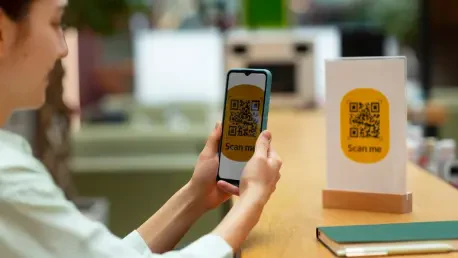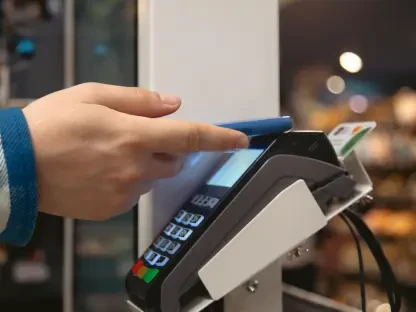In an era where the line between physical and digital experiences continues to blur, QR codes have emerged as a transformative tool, seamlessly connecting consumers with brands in ways that were once unimaginable, offering instant access to personalized content with a simple scan. Their resurgence in recent years has redefined marketing strategies, providing a contactless, efficient way to engage audiences while collecting valuable data. This analysis delves into the growing trend of QR codes in consumer engagement, exploring their adoption, real-world applications through a notable case study, expert insights on effective strategies, and the potential future of this technology in shaping brand interactions.
The Rise of QR Codes in Modern Marketing
Growth and Adoption Trends
The adoption of QR codes in marketing has skyrocketed, with industry reports indicating a significant uptick in consumer scans, driven by the widespread use of smartphones and mobile payment systems. Statistics suggest that engagement rates through QR codes have risen sharply, with millions of scans recorded monthly as brands integrate them into packaging, advertisements, and retail spaces. This growth reflects a broader shift toward interactive, tech-driven solutions that cater to a digitally savvy audience seeking convenience and instant access.
A pivotal factor in this revival has been the post-pandemic demand for contactless interactions, positioning QR codes as a safe and versatile option for menus, payments, and product information. Their presence is now ubiquitous across sectors, from retail to hospitality, as companies leverage them to bridge offline and online touchpoints. This trend shows no signs of slowing, with projections indicating sustained growth in usage over the coming years.
Integration into digital campaigns has further amplified their impact, enabling brands to track consumer behavior and tailor experiences based on real-time data. Unlike traditional marketing tools, QR codes offer measurable insights, making them indispensable for companies aiming to optimize outreach. This adaptability ensures they remain a cornerstone of innovative marketing strategies.
Real-World Impact: Momofuku Goods Case Study
Momofuku Goods, a consumer packaged goods brand specializing in pantry staples, exemplifies the power of QR codes in enhancing retail customer engagement. By partnering with Brij, a platform for personalized digital experiences, the company has strategically placed QR codes on Amazon inserts and utilized them during in-person activations. This approach has allowed for dynamic interactions that resonate with a broad audience, driving digital connections from physical purchases.
A standout result of this initiative is the remarkable 70% email collection rate from retail customers, a demographic often challenging to reach through conventional digital channels. This success highlights how QR codes can transform passive buyers into active participants in a brand’s ecosystem. The ability to capture such data has proven instrumental in building a loyal, engaged community around the brand’s offerings.
Beyond data collection, Momofuku has used QR codes to streamline content delivery, curating seasonal recipes and promoting new launches directly through digital landing pages. This flexibility reduces dependency on extensive tech support, empowering marketing teams to adapt quickly to consumer trends. Such practical applications underscore the scalability of QR codes as a tool for sustained growth in competitive markets.
Expert Perspectives on QR Code Strategies
Emma Hughes, Senior Manager at Momofuku, offers valuable insights into the hurdles of connecting with retail audiences and how QR codes have addressed these challenges. She notes that reaching consumers in physical retail spaces often lacks the direct feedback loop of online channels, making data capture a complex task. QR codes, however, provide a solution by enabling instant access to consumer preferences through targeted digital experiences.
Hughes also emphasizes the importance of strategic design in QR code campaigns, recommending that email signup incentives be prioritized as the first interaction in digital modules. This approach maximizes the likelihood of capturing contact information, which is critical for long-term engagement. Testing various offers, such as coupons or sweepstakes, has been key to achieving registration rates above 15%, a benchmark for effective campaigns.
Further expert advice focuses on the need for continuous experimentation with QR code placements and content to refine user engagement. Tailoring offers to specific demographics or seasonal trends can significantly boost interaction rates, ensuring that the technology remains relevant. These insights provide a roadmap for brands looking to harness QR codes as a cornerstone of their marketing toolkit.
The Future of QR Codes in Consumer Engagement
Looking ahead, QR code technology holds immense potential for deeper personalization, with possibilities for integration into augmented reality experiences that offer immersive brand interactions. Imagine scanning a product to unlock a virtual showcase or tutorial—this could redefine how consumers perceive and connect with goods. Such advancements promise to elevate engagement to unprecedented levels across diverse industries.
Additionally, enhanced data analytics tied to QR codes could provide brands with granular insights into consumer behavior, enabling hyper-targeted campaigns. However, challenges like consumer privacy concerns must be addressed to maintain trust, alongside the need for intuitive, seamless interfaces that prevent user frustration. Balancing innovation with accessibility will be crucial for widespread adoption.
The broader implications of this technology span retail marketing, loyalty programs, and omnichannel strategies, potentially reshaping how brands build lasting relationships with customers. As scalability becomes a focal point, QR codes could serve as a unifying thread across physical and digital platforms, offering tailored experiences at every touchpoint. Their evolution will likely influence how industries approach customer-centric innovation in the near term.
Key Takeaways and Call to Action
Reflecting on the journey of QR codes, their proven effectiveness in driving consumer engagement stands out as a game-changer for brands navigating the digital-physical divide. The success of Momofuku Goods serves as a compelling model, demonstrating how strategic implementation can yield significant results in data collection and audience growth. Moreover, the potential for future advancements in this technology hints at even greater opportunities for personalized marketing.
The importance of QR codes as a bridge between tangible and virtual interactions is reaffirmed through various applications, from retail activations to dynamic content delivery. Brands that embrace this tool gain a competitive edge by fostering direct, meaningful connections with consumers. This adaptability is key to their sustained relevance in a fast-evolving landscape.
Moving forward, businesses are encouraged to explore QR code strategies, focusing on innovation to meet rising consumer expectations for tailored experiences. Experimenting with new formats and integrations could unlock untapped potential, ensuring relevance in a crowded market. The path ahead invites brands to rethink engagement, leveraging this versatile technology to build stronger, more responsive relationships with their audiences.









